On The Supreme Court Hearings and The Pro-Khatna FAQs Circulated by Bohras

By Shabana FerozeCountry: Bahrain The Supreme Court of India is very close to deciding a ban on Female Genital Cutting (FGC) or khatna, and I couldn’t be happier. As a survivor of FGC myself (I live in Bahrain but had khatna done to me in a shady house in Hyderabad, India), I want to see this practice legally banned. The Supreme Court observed it goes against the Constitution of India to make any changes to a young girl’s private part. In my opinion, Female Genital Cutting goes against not only the Constitution, but child rights and human rights as well. The argument by pro-khatna Bohras against this is always “religious freedom”, as is evident in the name of the group at the forefront of defending khatna: the Dawoodi Bohra Women for Religious Freedom. What religious freedom? You’re allowed to do anything in the name of religious freedom? I really hope that the Supreme Court rules to have this practice declared illegal once and for all so Bohra moms stop bringing their daughters from all over the world to get a part of their anatomy removed for no reason. But what scares me is that even if it gets banned, the practice may go underground and still continue. A few members of the Bohra community who are pro-khatna (and the Syedna, the leader of the community) vehemently defend the practice, saying that it’s their right to do it, and that parents don’t need the consent of a 7-year-old girl child to make non-medical changes to her clitoris. They also claim that the procedure is done for “taharat” or “religious purity”. There was even a document circulated on WhatsApp recently, called “Female Circumcision, as practiced by the Dawoodi Bohras: Understand it, before condemning it!”. The document is structured like an FAQ, listing all the arguments against FGC and countering them with their supposedly good and right reasons in favour of this practice. This document claims that the Bohra form of FGC is not the same as Female Genital Mutilation (FGM), and that khatna does not cause any physical harm, trauma or even pain. This claim ignores all the personal stories of women who have said that it caused harm, long-lasting trauma, and terrible pain to them (including myself). The authors of the document also state that the World Health Organization (WHO) has “over-reached” in including Bohra khatna in their classification of FGM. Do they think they are smarter than the World Health Organization? They also compare nose and ear piercings to FGC. The document claims: “Nose & ear piercings, a very popular practice world over, is commonly performed on small girls for non-medical purposes. Nose & ear piercings are painful and cause a publicly visible & permanent change on the human body. Yet they are considered perfectly acceptable. On the other hand, female circumcision, which is a mild & harmless practice causing no visible change, is considered to be a human rights violation!” Making a piercing in the cartilage of the nose and ear is very different to cutting off a piece of genitalia. The genitalia is connected to your sexual organs and reproductive system. It’s not a harmless procedure. Nose and ear piercings are harmless procedures, available at hospitals and pharmacies, and are done by trained professionals. The WHO doesn’t have a problem with it. It’s not banned in several countries. So the comparison of nose and ear piercings to FGC/ khatna is not on the same level. Looking at the Bohra community’s arrogant defiance to continue this practice, even in the face of organizations such as WHO, I’m scared that even if the Supreme Court makes it illegal, it will continue to happen. It’ll just be shrouded in more secrecy. The Syedna himself needs to declare it to be an outdated and unnecessary tradition that needs to be stopped. If he doesn’t and it becomes illegal in India, a huge network of home-based cutters might grow, and women might continue to take their daughters, granddaughters and nieces to dark homes in small alleys to get it done.
A conversation with change makers: women who chose to speak up about Khatna

By Priya Ahluwalia Priya is a 22-year-old clinical psychology student at Tata Institute of Social Sciences – Mumbai. She is passionate about mental health, photography and writing. She is currently conducting a research on the individual experience of Khatna and its effects. To read Priya’s first blog in this series, visit ‘How I found out Khatna exists and why I choose to speak out’. The first time I heard the statement,“Well it could have been you! It could have been anyone! But it happened to me,” by a woman who had gone through khatna, I felt its weight immensely on me. I do not yet have the answers for why this statement affected me so intensely, but it has strengthened my resolve to understand and generate more awareness about Khatna, because it has affected women for so long and has the capacity to affect many more. The first step in my research journey is to talk to women who have been directly affected by Khatna. While deciding upon the questions to ask my participants, my number one concern was to not sound insensitive or biased when asking them about Khatna. More importantly, I wondered how to ask questions about something this personal without sounding intrusive. The sensitivity of the questions depends on the context in which you ask the question rather than how you frame it, whereas the intrusiveness of it depends on the reactions from the women. It was interesting for me to observe that none of the women found the questions to be intrusive or uncomfortable, rather there was a normalized, patterned response given from them, as if these were routine questions. My early hypothesis was that women would feel overwhelmed while responding to these questions, but that is not what I found. There are two possible reasons for this: one, they have been asked these questions before and thus have already reflected on the questions and know the answers for themselves; two, by choosing to speak about Khatna, they have already begun their healing process and by normalizing speaking about the incident they perhaps have taken back a sense of control that they had lost when they underwent it. Future interactions with more women will allow me to formulate a definite conclusion. It was fascinating to observe that although each woman had an individual experience of Khatna, their stories were eerily similar and the trajectory of growing up and figuring out the significance of it was uncannily alike. A lot of the women I interviewed had repressed their memory of the day of their Khatna, and they grew up without any conscious knowledge of what had happened or what it meant, only to discover its significance much later in life. However, perhaps their discovery of Khatna later in life comes due to the ripple effect created by one woman speaking out. The women I have spoken with have talked about how hearing how other women were speaking about their experiences helped them to remember their own experience of Khatna. While interviewing women, some common traits I found among the respondents were curiosity, a fierce need for answers and an extraordinary amount of courage. All the women I interviewed had an aura of strength around them which was empowering. It crushed the fear and hesitancy I had in asking the questions, and it empowered me to not only raise more questions about Khatna. Through reflection, I found that change happens through empowering conversations. While doing this research, always at the back of my mind, has been the questions of “Who are the changemakers?” I recognized that change-makers are those who have the courage to question the law of the land, who show resilience in the face of daunting challenges and who empower others to fuel the fire of change. These women have empowered me to continue the change, and I request you to join me in further promoting this change. If we do not speak out, then who will? To participate in Priya’s research, contact her on priya.tiss.2018@gmail.com
Why the new survey on Khafz (Female Genital Cutting) among Bohras is biased and unscientific
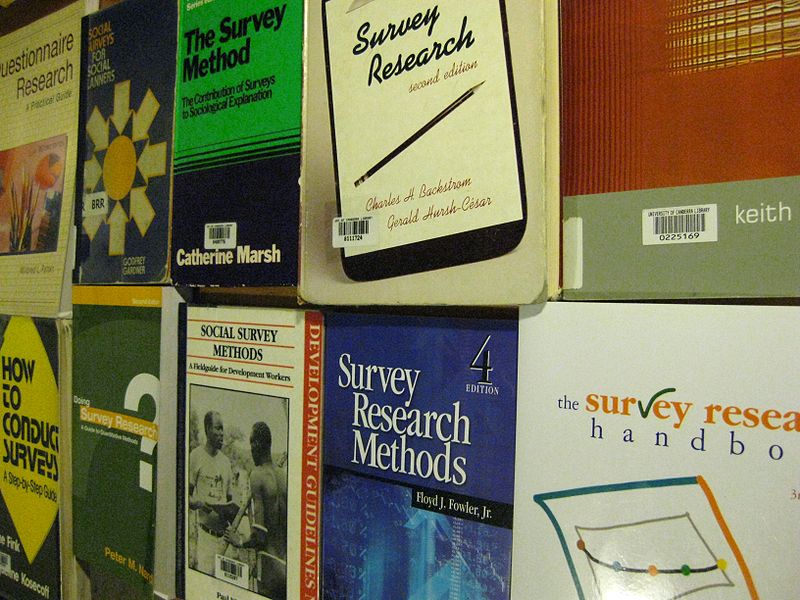
By Mariya Taher, MSW, MFA Last week, many Dawoodi Bohras around the world received the link to an online “research” survey with questions about Khatna/Khafz practiced in the community. Khafz refers to cutting a portion of a girl’s clitoral hood – a type of Female Genital Cutting – and this new online survey by Dr. Tasneem Saify, Dr. Munira Radhanpurwala T and Dr. Rakhee K claims that it aims to get feedback from Dawoodi Bohra women and men about the practice. (Link to survey is here). As someone who has gone through the process of designing multiple research studies, I can confidently say that this latest survey on Khatna/Khafz in the Bohra community is neither a safe nor an unbiased tool for conducting proper research on female genital cutting. Other academic researchers who reviewed the Khafz survey have also pointed this out. For example, Usha Tummala-Narra, Ph.D., an associate Professor in the Department of Counseling, Developmental and Educational Psychology at Boston College, states: “The questions are strangely worded, and implicitly and explicitly suggest that the practice is not mutilation or traumatic. There are also no questions related to girls’ or women’s experiences of the practice. We can’t really know much about the definition of khatna/khafz without asking about the experience and its effects over time.” While Karen A. McDonnell, an Associate Professor and Vice-Chair in the Department of Prevention and Community Health at Milken Institute School of Public Health at the George Washington University, states: “Overall this survey presents itself as a feedback mechanism from Dawoodi Bohras about female circumcision. Taking the perspective of someone trained in objective survey development in psychology and public health, the survey actually reads in its entirety, not as a feedback, but rather as a tool for marketing a perspective. As the survey proceeds, the tenor of the questions increase in a lack of objectivity and a central cause/message is quite clear and the respondent is made to feel manipulated.” While all research has its limitations, the design of this questionnaire suggests that it clearly was NOT created and sent out into the world to collect empirical unbiased research on the practice FGC/Khatna/Khafz. Instead, the bias and manner of wording of this survey tool express that the authors (Dr. Tasneem Saify, Dr. Munira Radhanpurwala T & Dr. Rakhee K) are seeking responses that will justify their motives to prove that Female Genital Cutting (FGC) does not harm girls. Which makes me wonder, was this research tool (the survey) even vetted before the study’s implementation? In 2008, because of my increasing passion to end violence against women, I choose to craft and carry out research for my Master of Social Work thesis on “Understanding the Continuation of Female Genital Cutting Amongst the Dawoodi Bohras in the United States.” The issue had been in the recesses of my mind for years and I wanted to learn how a practice that involves cutting the sexual organs of a young girl could ever have been deemed a religious or cultural practice. I wanted to understand how the issue of Female Genital Cutting (FGC) could continue generation after generation without question, because if I could understand this reasoning, then I could better understand why FGC had been done to me at the age of seven. As a graduate student, my thesis advisors walked me through every step of the research process, from consulting references and existing studies, to contacting other academics and experts who had studied FGC. In the end, I carried out an exploratory study and crafted questions that could be used to conduct ethnographic interviews. Ethnographic interviewing is a type of qualitative research that combines immersive observation and directed one-on-one interviews. In order to draft the questions, I consulted questions used in previous studies by other researchers. My thesis advisors reviewed the questions, and the San Francisco State University’s Institutional Review Board examined my question to ensure there was no hidden bias in the wording of my questions that could lead participants to answer one way or the other. Having been through the process once, and understanding the importance of having multiple individuals review your questions for hidden biases, years later, I went through a similar process when Sahiyo designed its study on Khatna among Dawoodi Bohra women. Prior to engaging Bohra women for the study, our research tool (the survey) was vetted by many NGOs and expert researchers. If this newest Khafz questionnaire by Dr. Tasneem Saify, Dr. Munira Radhanpurwala T & Dr. Rakhee K had been vetted by other individuals and institutions, it would have recognized the following problems well before releasing the study to the public. 1) Participant consent Prior to filling out a study, it is important that participants are informed of the study’s intention and are able to sign a consent form acknowledging that they understand the study’s purpose and are giving their permission for the findings to be used in a study’s report. The new Khafz -survey does not have a consent form that does such. [See Screenshot to the left]. In fact, the purpose of this survey is misleading to the reader. There is no mention of how the respondents are being recruited and if their responses will be anonymous or even held in confidence and in essence violates a respondents rights as a participant. 2) Confidentiality The new Khafz survey form requires participants to provide information that will NOT allow their information to remain private. The study requires that participants add their Community ID (ITS52/Ejamaat) Number. As reported in Mumbai Mirror, the ITS number keeps track of a Dawoodi Bohra’s personal details, including the number of times a person visits the mosque. By requiring an individual to enter this information, already the researchers have directly violated a person’s right to privacy. The question also limits respondents to only those who have signed up for such an ITS number. This, therefore, rules out the participation of many individuals born into the Bohra community or to a Bohra parent who may not have signed up
બોહરાઓ વચ્ચે આધુનિક્તાની ખોટી માન્યતા
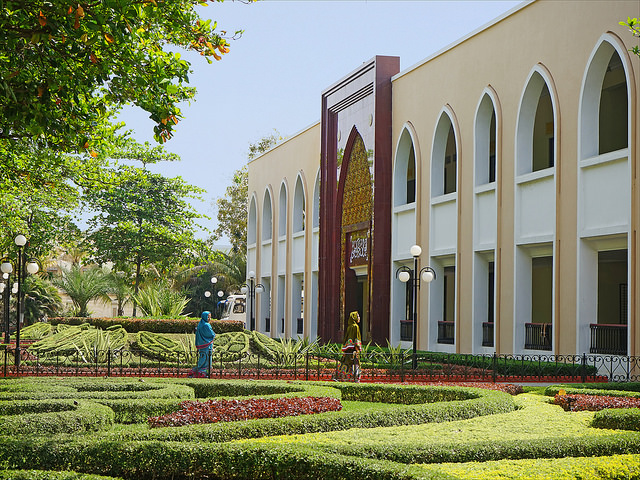
આ આર્ટિકલ પહેલા સહિયો દ્વારા તારીખ 11 મે 2017ના રોજ અંગ્રેજીમાં પ્રકાશિતકરવામાં આવ્યો હતો. Read the English version here. લેખક: અનામી ઉંમર : 33જન્મનો દેશ : ભારતવર્તમાન નિવાસસ્થાન : અમેરિકા હું દાઉદિ બોહરા કુટુંબમાં જન્મેલો મરદ છું. યુનાઈટેડ સ્ટેટ્સમાં મારો અને મારા ભાઈનો ઉછેર એકદમ સામાન્ય રીતે થયો છે. અમે અમેરિકાના એક ખૂબ જ ધર્મનિરપેક્ષ મંડળના સભ્યો હતા. મારા માતા-પિતા હંમેશા મને કહેતા કે અમે કેવી રીતે અન્ય મુસ્લિમો કરતા અલગ હતા. અમારો સમાજ અમારા દીકરાઓ અને દીકરીઓના શિક્ષણ ને મહત્વ આપતા. આપણા સમાજમાં ઘણા બૈરાઓ વ્યાપાર કરે છે, ડૉક્ટરો છે અને પોતે ઘરખર્ચ ઉપાડે છે. અમે વહાબી તો નથી જ. મને સ્પષ્ટ રીતે યાદ છે કે મારા “મિસાક” લેવાના સમયે, હું મારા માતા-પિતા સાથે “20/20” ન્યૂઝ પ્રોગ્રામનો એક એપિસોડ જોતો હતો. તેનો એક ભાગ સોમાલિયાના ફીમેલ જેનિટલ મ્યુટિલેશન વિષે હતો. અમે તે પૂરો ભાગ જોયો અને રૂમમાં શાંતિ પ્રસરી ગઈ… જ્યારે તમે માતા-પિતા સાથે ફિલ્મ જોતા હો અને પ્રેમનું દ્રશ્ય આવે ત્યારે જેવી મૂંઝવણ અનુભવો તેવી મૂંઝવણ થવા લાગી. મારા માતા-પિતા શા માટે શરમ મેહસુસ કરતા હતા તે મને સમજાયું નહિં પરંતુ, થોડા દિવસો પછી બધા તે બાબતને ભૂલી ગયા. દશ વર્ષ પછી, હુંએક દાઉદિ બોહરા બૈરી સાથે લાગણી સભર સંબંધ ધરાવતો હતો (જે અત્યારે મારી પત્ની છે). પહેલી વાર જ્યારે અમે સંભોગ કરતા હતા ત્યારે તેણી ખૂબ જ રડવા લાગી. તેણી સાથે શું કરવામાં આવ્યું હતુ તે વિષે મને વાત કરી. જ્યારે તેણીએ કૉલેજમાં આ બાબત વિષે સાંભળ્યું ત્યાં સુધી તેણીને પોતાને ખબર નહોતી કે તેની સાથે શું કરવામાં આવ્યું છે. જ્યારે તે પ્રક્રિયા તેણી પર કરવામાં આવી ત્યારે તેણીએ પગના અંગૂઠા સુધી પીડા આપતો વીજળીનો જટકો મહેસુસ કર્યો પરંતુ, હું એ પ્રથમ વ્યક્તિ હતો જેણે એ તરંગનીઅસરમેહસુસ કરી હતી. તેણી ડરી ગઈ હતી અને કંઈક ગુમાવ્યાની લાગણી અનુભવતી હતી.તેણીની ખૂબ ઈચ્છા હતી કે મારી સાથે સંભોગ માણી સંબંધોને ગાઢ બનાવે પરંતુ, તેવું ક્યારે થઈ શક્યું નહિં. એક સંપૂર્ણ બૈરી તરીકેની તેણીની ક્ષમતા સાથે એ સુખ, યુવાવસ્થામાં જ તેણીની મરજી વિના છીનવી લેવામાં આવ્યું હતુ. અમે સાથે મળી તેનો સામનો કર્યો. મેં તેણીનું કાઉન્સેલિંગ કરાવ્યું અને તેણીને ફરી ખાતરી આપી કે આપણો પ્રેમ વધુ મજબૂત થશે પરંતુ, તેણી અને હું બન્ને જાણતા હતા કે એ ક્ષણે તેણીએ જે ગુમાવ્યું છે તે ક્યારેય કોઈપણ વ્યક્તિ પાછું આપી શકશે નહિં. અંતે, “20/20”ની એ ક્ષણ મને સમજમાં આવી. બે દિકરાઓ ધરાવતા મારા માતા-પિતાએ ક્યારેય તેમના બાળકોમાં શારીરિક બદલાવ કરવા જેવો પીડાદાયક નિર્ણય કરવો પડ્યો નહોતો પરંતુ, સ્પષ્ટ રીતે કહું તો જો અમે બન્ને ભાઈઓ માંથી કોઈ એક દિકરી હોત તો આ પ્રક્રિયાને અનુસરવા માટે જબરદસ્ત દબાણ કરવામાં આવ્યું હોત. સમાજ તેની ખોટી વાતો ફેલાવે છે કે એ “તમારા સુખી લગ્ન જીવન માટે છે”, “તમે સારી પત્ની બની શકો તે માટે છે.” પાછળથી મારા માતા-પિતા પાસેથી મને જાણવા મળ્યું કે મારા કુટુંબની બધી દિકરીઓ પર આ પ્રક્રિયા કરવામાં આવી છે. હું આ વાત માની શક્યો નહિં. જ્યારે તમારા 50% બાળકો મધ્યયુગની પ્રથાનો ભોગ બની રહ્યાં છે તો શા માટે તમે આધુનિક્તાનો મુખોટો પહેરીને ફરો છો? જો તમારી સંપૂર્ણ આધ્યાત્મિક બનવાની પૂર્વ શરત તેમના માટે શારીરિક કમી હોય તો બૈરાઓની સ્વતંત્રા સાથે છેડછાડ કરવાનું બંધ કરો. મારી સુંદર પત્નીએ મને ઘણુ બધું શીખવ્યું છે. તેણીએ મને માફ કરવાનું અને શક્તિ આપવાનું શીખવ્યું છે. જો હું મારી પત્નીની જગ્યાએ હોત તો ચોક્કસ મેં તેનો વિરોધ કર્યો હોત.સમય આવી ગયો છે કે બધા દાઉદિ બોહરા સાથે મળીને આ મુદ્દાનો ઉકેલ લાવે.આ પ્રક્રિયા આસ્થા પર એક કલંક છે.ઈસ્લામમાં તેનું કોઈ સ્થાન નથી, તે આપણા બૈરાઓને ભરપાઈ ના થઈ શકે તેવી હાનિ પહોંચાડે છે અને આ પ્રક્રિયા, આપણે આધુનિક અને નમ્ર મુસ્લિમો હોવાનો દાવો કરીએ છીએ તેનાથી વિપરીત છે. આ મુદ્દાને અંધકાર માંથી પ્રકાશમાં લઈ આવવાનો સમય આવી ગયો છે.
Building the data on Female Genital Cutting in the Bohra Community
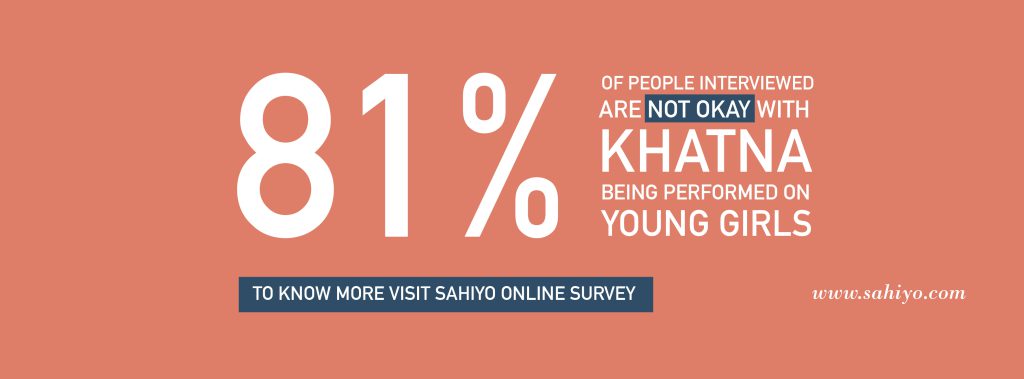
In February 2017, Sahiyo released the findings of the first ever large scale global study on Female Genital Cutting in the Bohra community in order to gain insight into how and why this harmful practice continued. A year later, this February 2018 saw the release of a second large-scale research study entitled “The Clitoral Hood – A Contested Site”, conducted by Lakshmi Anantnarayan, Shabana Diler and Natasha Menon in collaboration with WeSpeakOut and Nari Samata Manch. The study explored the practice of FGM/C in the Bohra community specifically in India and added findings about the sexual impact of FGC on Bohra women. Substantial overlap between the two studies can be found and parallels can be drawn. Firstly, both studies explored the type of FGM/C that was carried out on the participants. The study by Sahiyo discovered that out of the 109 participants who were aware of the procedure that was carried out on them, 23 reported having undergone Type 1a – the removal of the clitoral hood. Research carried out by Anantnarayan et. al. found that although proponents of FGM/C in India claim that Bohras only practice Type 1a and Type 4 FGM/C (pricking, piercing or cauterization of the clitoral hood), participants reported that both Types 1a and 1b (partial or total removal of the clitoris and/or clitoral hood) are most often practiced. Sahiyo and Anantnarayan et. al. both found that the majority of participants had undergone FGM/C and therefore, among both samples, FGM/C was widely practiced. Sahiyo found that 80% of 385 female participants had undergone the practice, whereas Anantnarayan et. al. found that of the 83 female participants in the study, 75% reported that their daughters had undergone FGC. Both studies found that FGM/C was performed at around the age of seven. The impact of FGM/C on participants was also reported to be similar among participants of both studies. In exploring this further, Anantnarayan et. al. found that 97% of participants remembered FGM/C as a painful experience. Participants who had undergone the practice reported painful urination, physical discomfort, difficulty walking, and bleeding to be the immediate effects after having undergone FGM/C. In the long-term, some women reported that they suffered from recurring Urinary Tract Infections (UTIs) and incontinence, which they suspect could be linked to their khatna. Both studies also explored the effect of FGM/C on participants’ sex lives. Anantnarayan et. al. found that approximately 33% of participants believe that FGM/C has negatively impacted their sex life. Similarly, Sahiyo reported findings of 35% of participants who believed that FGM/C has negatively impacted their sex lives. Some of the problems identified by several participants included low sex drive, the inability to feel sexual pleasure, difficulty trusting sexual partners, and over-sensitivity in the clitoral area. Physical consequences of FGM/C in both studies also revealed psychological consequences. Similar to Sahiyo’s findings, Anantnarayan et. al. found that many participants reported feelings of fear, anxiety, shame, anger, depression, low self-esteem, and difficulty trusting people as some of the psychological repercussions of their FGM/C experience. Sahiyo found that 48% of participants in their study reported that FGM/C had left them with a lasting psychological impact. Both Sahiyo and Anantnarayan et. al. also explored the main reasons for the the continuation of FGM/C within the Bohra community. Several common reasons were found, including the continuation of an old traditional practice, the adherence to religious edicts, and to control women’s promiscuity and sexual behaviour. Interestingly, Sahiyo’s study found that 80% of women had earned at least a Bachelor’s degree, no relationship could be determined between education level and having undergone FGC. Meanwhile, the study by Anantnarayan et. al found that a strong connection existed between a mother’s education level and her decision to continue FGC on her daughter. Sahiyo’s study, however, did note that more important than education level was the question of a person’s ideological preference (stated religion) as it might influence a person’s decision to continue FGC on their daughter. In fact, Sahiyo’s survey found that those who were most likely to continue ‘khatna’ were also more likely to still identify as Dawoodi Bohra in their adult life. Anantnarayan et. al also determined that the more diverse personal networks and economic independence from the Bohra religious community a woman had, the more likely they were to discontinue FGM/C and renounce it. Finally, both studies examined the relationship between men and the decision/involvement for a girl to undergo FGC. Both studies did allude to the idea that the decision leading to a girl undergoing FGM/C may not strictly be confined to women. Sahiyo’s study revealed that 72% of respondents believed that men were aware of the practice, but only 27% believed that men were told of the practice when the girl underwent it in their family. Anantnarayan et. al. concluded that men played an integral role in the maintenance and propagation of the practice, both at the personal and political level, whether passively or more actively. However, Sahiyo’s data collection was completed in 2016, prior to the large-scale movement to end FGC in the Bohra community. The last few years have shown that with an increase in awareness of FGC amongst the public, Bohra men’s own knowledge of FGC has also naturally increased, and thus the traditional idea that men are unaware of FGC may in fact be changing with the current generation, as pointed out by Anantnarayan et. al.
ફીમેલ જેનિટલ કટિંગની આ પ્રથાને ફક્ત એકલા કાયદા દ્વારા જ સમાપ્ત કરી શકાય નહિં

આ આર્ટિકલ પહેલા સહિયો દ્વારા તારીખ 26 એપ્રિલ 2017ના રોજ અંગ્રેજીમાં પ્રકાશિત કરવામાં આવ્યો હતો. Read the English version here. લેખક : સબિહા બસરાઈ દેશ : કેલિફોર્નિયા, અમેરિકાઉંમર : 34 વર્ષ એફ.જી.સી. અથવા બોહરા સમાજ જેને ખતના તરીકે ઓળખે છે, તે મુદ્દો અંધકાર માંથી બહાર આવ્યો છે અને લોકો તેના વિષે ખુલ્લેઆમ વાત કરે છે એ મહત્વનું છે. ઘણા લોકો જાણતા નથી કે આ પ્રથા કેટલી ક્રૂર છે અને બૈરાઓની સેક્સ્યૂઆલિટી સંબંધી શરમને કારણે તેમજ મરદપ્રધાન સમાજની રચના દ્વારા લાગુ કરવામાં આવેલ રીપ્રોડક્ટિવ હેલ્થ (પ્રજનનક્ષમ સ્વાસ્થ્ય)ને કારણે લોકો એ વિષે વાત કરવાનું ટાળે છે. હું આશા રાખુ છું કે નાની દીકરીઓ પર એફ.જી.સી. ની પ્રક્રિયા કરવાના આરોપ હેઠળ એક બોહરા ડૉક્ટરને ગિરફ્તાર કરવામાં આવ્યા હોવાનો ડેટ્રોઈટનો કેસ ઘણાં કુટુંબોને આ પ્રથા ના અપનાવવા માટે પ્રોત્સાહિત કરશે જેથી, નવી પેઢીની નાની દીકરીઓને આવી પ્રથાઓ હેઠળથી પસાર ના થવું પડે. આ હાનિકારક પ્રથાનો મુદ્દો ધાર્મિક અથવા અધાર્મિક હોવું નથી. આ મુદ્દો સાચા અથવા ખોટા હોવાનો પણ નથી. પરંતુ, ખરી વાત એ છે કે ખતના પ્રક્રિયા એક અનુચિત કાર્ય છે. જો કે, ડેટ્રોઈટના કેસમાં બન્યું તેમ, અમેરિકન મુસ્લિમ પરની દેખરેખ ચિંતાઓ ઊભી કરે છે. આપણી મસ્જિદો અને કમ્યૂનિટિ સેન્ટરો પર પહેલાથી જ સરકારી એજન્સીઓ દેખરેખ રાખી રહી છે, જે આપણને જાતીભેદ કરીને આપણા સામાજીક અધિકારોનો ભંગ કરે છે. બધા બોહરાઓએ તે સમજવું મહત્વપૂર્ણ છે કે સરકારી એજન્સીઓના મનમાં આપણું હિત જ હોય એ જરૂરી નથી અને ખતનાના મુદ્દાનો લાભ ઉઠાવી તેઓ વધારે ત્રાસ આપવાનું અને આપણા સમાજ પર વધારે દેખરેખ રાખવાનું ઉચિત માની શકે છે. ખતના પ્રથા સમાપ્ત થવી જોઈએ પરંતુ, મારૂં માનવું છે કે સમાજને શિક્ષિત કરવા દ્વારા અને જમાતો (બોહરા સમાજની સભાઓ)ના આયોજનો દ્વારા જ આ પ્રથાનો સાચો અંત થશે. આપણામાંથી કોઈ ઈચ્છતું નથી કે આપણા સમાજમાં જબરદસ્તી કરવામાં આવે પરંતુ, આપણે સમજવું જોઈએ કે ફક્ત કાયદા દ્વારા જ તેનું સમાધાન થઈ શકે નહિં અને કેટલાક કિસ્સાઓમાં, સરકારી એજન્સીના અમુક અધિકારીઓની નકારાત્મક કાર્યવાહી આપણા સમાજની સુરક્ષા અને સલામતી માટે હાનિકારક રહી છે. તેથી, અમેરિકામાં રહેતા બધા બોહરાઓને હું સાવચેત કરું છું કે વકીલની હાજરી વિના સરકારી એજન્સીઓ સાથે ક્યારે વાત કરવી નહિં અને આપણા સમાજે સાથે મળી ખતના જેવી હાનિકારક પ્રથાઓને બંધ કરવાના માર્ગ શોધવા માટે પણ હું બધા બોહરાઓને પ્રોત્સાહિત કરવા માગુ છું.
Shifting terrains: Lessons learnt from the first U.S. Activists Retreat for Bohras against Female Genital Cutting
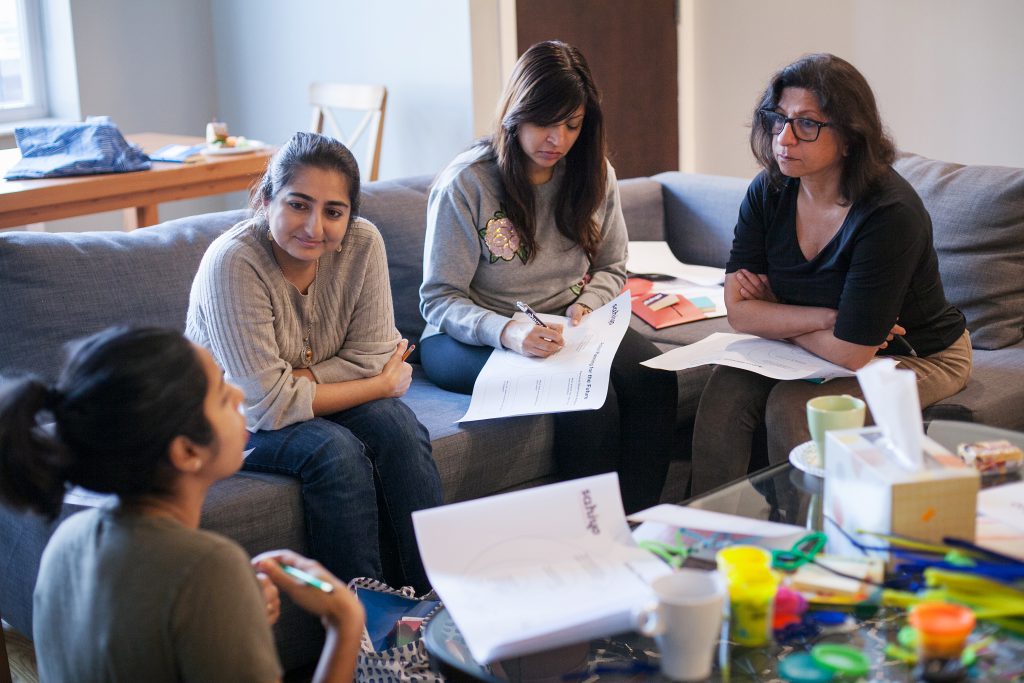
(This post was originally published on the blog of Georgetown University’s Berkley Center for Religion, Peace, and World Affairs, the Berkley Forum) By Mariya Taher, MSW, MFA In this day and age when social media has penetrated our lives, 24-hour news cycles shape our worldviews, and there is never enough time to process the influx of information coming at you, it’s often difficult to remember that social change is slow, hard work, much like pushing a heavy rock up a steep hill. With the #MeToo movement heavy on people’s minds, it’s easy to feel that change is imminent, that no longer will women cower in fear from the sexual harassment and violence generation after generation has experienced due to their genders. Yet, as someone who has dedicated the past ten years of her life towards ending gender violence of all kinds, unfortunately, the real hard truth is that social change does take time, and the seeds of that social change must be planted in the generations proceeding ours before they can even become fruit for future generations of girls and women. That message was one I hoped to convey to the ten women who accepted my invitation to gather in New York on January 19th through January 21st for what my organization Sahiyo called a “U.S. Dawoodi Bohra Anti-Female Genital Cutting Activists Retreat.” The women who came together, like me, had all been born into the Dawoodi Bohra Religion and Culture. Also, like me, these women felt encouraged to take an active role in preventing FGC or “Khatna” as it is known in the Dawoodi Bohra community, from occurring on girls of the next generation. I and my fellow Sahiyo cofounders have been planning this retreat for the past year. (Sahiyo will also host an Activist Retreat in India in mid-February 2018). We planned both these retreats because we had recognized from our own experience, that being an activist is emotionally and physically challenging, and often “we” did this work in isolation from one another. As activists, the challenges we face are often linked to the fact that FGC in our community developed due to a consistent repetition of the practice generation after generation. This caused it to become a deeply entrenched ritual many followed without question because that’s just the way it is. To challenge this norm, meant to challenge the wisdom of those who came before us, and in a sense admit that our religious traditions are fallible. Activists who do challenge FGC, often encounter the wrath of those who would simply let live a practice that has always been done. At the U.S. Activists Retreat, many of us spoke about the negatives that come with challenging your family and friends on the issue of FGC, as well as challenging other social norms an individual may no longer want to partake in. Some women at the U.S. Retreat spoke about the economic boycott their husbands’ businesses encountered, others spoke about friends who no longer spoke to them or about how they feared losing friendship (or support systems they have had since childhood) if they openly discussed FGC. Another woman told us about how she had to call the police on her own brother who harassed her for her activism against FGC and for voicing an opinion that contradicted the edict given by the Dawoodi Bohra religious leaders. In Greek mythology, Sisyphus was destined to consistently push a rock up a hill, only to have it roll back down repeatedly. Like Sisyphus, anti-FGC Activists can consistently be in a position where the rock rolls back down despite our valiant efforts to end FGC, particularly because we are struggling against deeply rooted frames about gender and religion, and the terrain is consistently tilted against us. When you believe you are the only one pushing that rock back up that hill, it can also be lonely. Often the emotional and physical needs of activists are overlooked, as are the struggles they or their families go through so that social change can happen. Prior to meeting the other women who would be the cofounders of Sahiyo with me, I spoke about FGC individually, and independently. I wrote my own story of undergoing it for Global Fund for Women. It was through writing my story that I connected to the additional women who would be my allies. Years later, I have recognized just how much I needed those women to not only validate the fact that my own feelings around Khatna were justified, but to also share in the emotional hardships that come with being one of a few voices who publicly speak against FGC. Connecting with the women who would become the other Sahiyo Co-founders had essentially broken the sense of isolation I didn’t even realize I was experiencing in walking the public life of an activist against FGC. [youtube url=”https://youtu.be/r3U5uv3keEQ”] We imagined it might be the same for other activists speaking out against FGC. The U.S and India Retreats, we believed, could be a space where activists could come together to share both the challenges and opportunities they have found in advocating against FGC. It could be a place where activists could gather, share their pain, their fears, and feel less alone in the advocacy work they pursue. The retreats could also be a safe space where as a team we could formulate action steps on how we could move forward in addressing FGC in our communities. For the U.S. Activists Retreat, as so much attention has been brought onto the topic of FGC since the arrest of Dr. Jumana Nagarwala, a Dawoodi Bohra woman who is accused of performing FGC on girls in Michigan, that discussing these next steps felt crucial. The Activists Retreat was the first of its kind in the United States for women who came from the Dawoodi Bohra culture and religion, and it was a step in the right direction in terms of activists recognizing that to truly ensure that FGC is abandoned by the majority
Here I am, sharing my story: Watch a Dawoodi Bohra woman narrate her Khatna experience
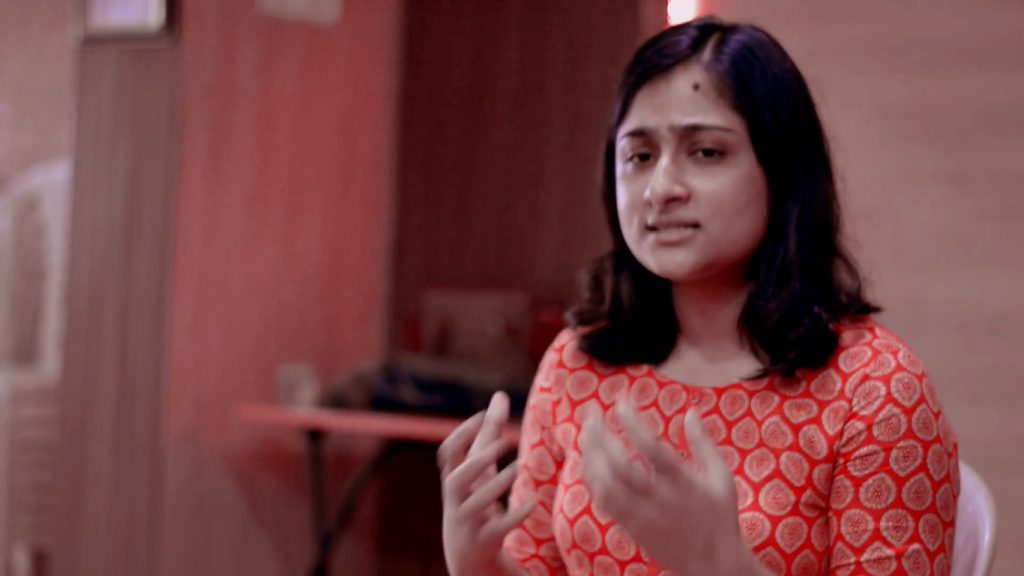
In October 2017, at Sahiyo’s third Thaal Pe Charcha event, a young Indian Bohra woman, Saleha Paatwala, shared her experience of being subjected to “khafz” — also known as khatna or Female Genital Cutting — with the other participants. On this International Day of Zero Tolerance towards Female Genital Cutting (FGM/C), watch this poignant video (below) of Saleha narrating her story. “When I was cut, I didn’t even know what part of me was taken away by them, and for what. I was just a 7-year-old girl then. I remember the pain of that ‘nick’, the embarrassment of lying naked in front of those women, and those goosebumps when they touched my private part,” said Saleha, explaining why she chose to speak out. “By sharing my story, I hope to reach out to those who have suffered and can’t find their voices, to those who are unaware of this practice and most importantly, to those who can help us eradicate FGM/C completely from our country.” [youtube url=”https://youtu.be/JZSpb9RVqFQ”]
To each his own! A perspective on Female Genital Cutting by a Kuwaiti Bohra
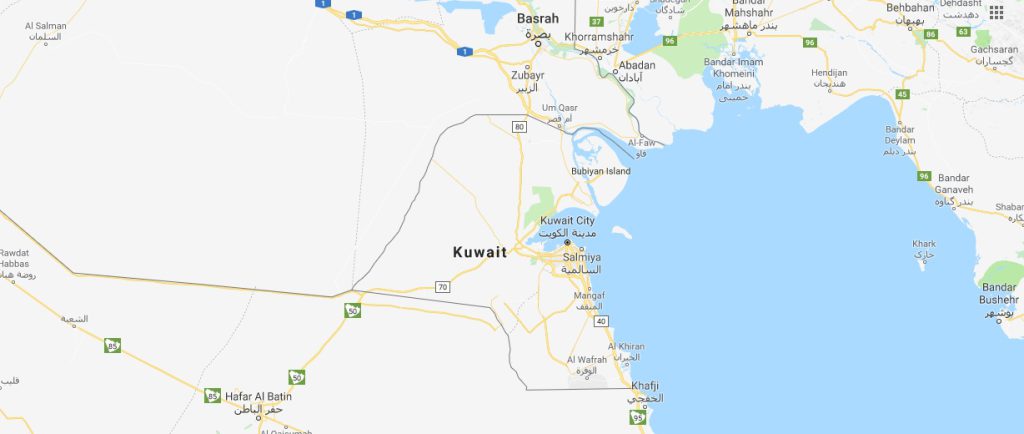
By Anonymous Age: 29Country: Kuwait I was 7 years old when Khatna happened during my summer vacation to India. I am sure my mother must have looked for other avenues to have khatna done on me in Kuwait but unfortunately since Kuwait is such a strict Muslim country wherein even an abortion is prohibited, she had to take me to India. The mid wife convinced me that she was trying to remove a (non-existent) worm from my privates, that too in a non-medical set up. I remember her surgical toys, how she just laid me on the floor and boom I spat out a loud cry!! Funny part, there was a boy my age there who was also getting a circumcision. Good for his penis! I remember what happened but I never knew the actual reason for it until I went to college and met another well-read Bohra girl who then enlightened me that what had happened to me was not something normal, it was not right! I really didn’t understand what she meant, but then I researched and read about all types of FGM being performed and I realized what happened to me was Type 1. I even asked my other Muslim friends if they were circumcised. Of course the answer was, “What the hell are you even talking about?” I didn’t know how to confront my parents about it because all my life I just thought khatna must be essential just like a vaccination of some kind. When I did confront them, it was so upsetting for me to learn that they didn’t even feel sorry for what they did to me. They simply said it was a tradition that Bohras have been following for years and if I want, I have the will to not continue this for my daughters. Simple! I am enraged even as I write this. I had to accept my fate and move on but I did make them realize that what they did was wrong and unnecessary. I am 29 today and no, I don’t face any of the issues that have been discussed on this forum like being depressed, traumatized, or broken. And no, I don’t face any issues with an orgasm or stimulation. But again, that does not mean that I support this nonsense. The simple pleasures of life that god has bestowed upon us, why should anyone take that away from us? I did visit a gynecologist recently and I had to ask her to check if my clitoris looks normal. Her response was “It’s almost there.” From what I understand, Type 1 FGM is where they remove the clitoral hood. My doctor said that my hood is very much there, but a snip on my clit was visible enough to know that something was wrong. She seemed confused and that’s when I had to explain to her that Khatna happens in India too. She was shocked as it was new information for her. She was from Chennai; little does she know it’s probably being practiced there too. Whenever I end up in a discussion about Khatna with my Bohra friends who have cut their daughters, they have no space for a logical debate. There are also parents who are aware of this wrongdoing and who have decided not to practice this on their daughters, but they are not involved in any sort of a debate with others. Which is great and it’s the best way to deal with it. To each his own! I have been following Sahiyo on Twitter and I do read the chain of ongoing debates. And in between I come across arguments by Bohra doctors who support this illegitimate act with on the grounds of equal rights between men and women for circumcision. It made no sense to me, but one male doctor said that if men can be circumcised for medical reasons, women in our community have the rights to do so as well for hygienic reasons. Really? I still have had a UTI and Candidiasis even after being circumcised! To that doctor: it’s great that you care about us so much, but if that’s the case, then ask us for our consent on this matter. We have the right to say yes or no just like in our marriages. Educate us about khatna in the madrasas. Teach us the medical benefits of this act. Enlighten us but only when we have hit puberty and not when we are naïve and gullible. Allow us to do our own research and decide for ourselves whether we want to get snipped or not.
એક બોહરા બૈરી દ્વારા સૈયદના માટે એક પત્ર
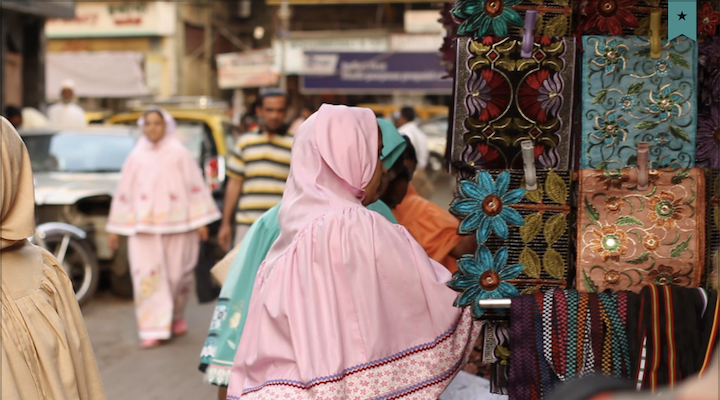
આ આર્ટિકલ પહેલા સહિયો દ્વારા તારીખ 12 મે 2017ના રોજ અંગ્રેજીમાં પ્રકાશિત કરવામાં આવ્યો હતો. Read the English version here. લેખક: અનામી રહેવાસી દેશ : અમેરિકા પ્રતિ, સૈયદના મુફદ્દલ સૈફુદિન, દરેક પરિસ્થિતિમાં અમે તમારી સાથે રહ્યાં, કોઈપણ પ્રશ્નો કર્યા વિના તમે કહ્યું તે માન્યું અને તમે કહ્યું તેવા કપડા પહેર્યા. જ્યારે તમે અમારા 53માં દાઈ બન્યા ત્યારે 53 નંબરને અપનાવવા અમે તમારા માનમાં અમે અમારી લાઈસન્સ પ્લેટો અને ફોન નંબંરોમાં બદલાવ કર્યા. અમારી સુખ-દુઃખની ક્ષણોમાં અમે તમારી રઝા લેવા આવ્યાં કે અમે અમારા પ્રિયજનને દફનાવીએ, અમે લગ્ન કરીએ કે અન્ય દેશમાં જઈએ વિગેરે. તમારા અને સમાજના ફાયદા માટે દાઉદિ બોહરા ટેક્સ રૂપે અમે અમારૂં ધન ખર્ચ કર્યું. અમે અમારી દિવાલોમાં તમારા ફોટા લગાવ્યાં. તમારા ઉપદેશો સાંભળવા અમે ટેક્સાસ, નાઈરોબી અને મુંબઈ જેવા સ્થળો સુધી મુસાફરી કરી. અમે તમને અને તમારા માટે દુવાઓ કરી. આ બધુ અમે સમાજના નામે અને આપણા ઇતિહાસ પ્રત્યે લાગણીના નામે કર્યું.અમે તમારી ભલમનસાઈ અને જ્ઞાન પર વિશ્વાસ કર્યો. અમે વિશ્વાસ કર્યો કે જ્યારે અમેતમને મદદ માટે બોલાવશું ત્યારે તમે આવશો. ગયા વર્ષે સૈયદના તેહર સૈફુદિનની પુણ્યતિથિ – એ દિવસ, જ્યારે તમને ખબર હતી કે આખું વિશ્વ તમને જોઈ રહ્યું હતુ – તે દિવસે તમે “આપણી આસ્થાને દ્રઢ રાખવા અને અડગ રહેવા” વિષે કહ્યું હતુ. “મોટા સાર્વભૌમ રાજ્યો (દા.ત. અમેરિકા) જે કંઈ કહે છે તે જો આપણી આસ્થામાં કોઈ બદલાવ લાવે તો પણ આપણે તેને સમજવા તૈયાર નથી. બસ, પ્રથાઅપનાવામાં આવવી જોઈએ. જો તે મરદનીપ્રથા હોય તો તે સાચી અને ખુલ્લેઆમ થઈ શકે છે. પરંતુ, એ પ્રથા બૈરાઓની હોય તો તે છૂપી રીતે થવી જોઈએ, પરંતુ કોઈપણ પરિસ્થિતિમાં તે પ્રથા આપનાવવામાં આવવી જોઈએ. કૃપા કરી, સમજો કે હું કઈ બાબત વિષે વાત કરવાનો પ્રયત્ન કરી રહી છું.” તમે કઈ બાબત વિષે વાત કરતા હતા તે અમે બધાસમજી ગયા હતા. તમે ખતના વિષે બોલી રહ્યાં હતા, દુનિયા આખી જેની નિંદા કરે છે તે એક એવી પ્રથા છે જેમાં કોઈ વ્યક્તિ દીકરીના ક્લિટોરિસના ભાગને કાપે છે. “મોટા સાર્વભૌમ રાજ્યો” (વાંચો: અમેરિકાના કાયદાઓ) નું શું કહેવું છે તેની પરવા કર્યા વિના તમે અમને અમારી યુવાન દીકરીઓ પર ખતના પ્રક્રિયાનો અમલ કરવાનું કહ્યું. એક મહિના પછી અમેરિકા સ્થિત જમાતોએ અને સમાજના સભ્યોએ કાયદાઓને અનુસરવો જોઈએ અને અમેરિકામાં ખતનાની પ્રથા અપનાવી જોઈએ નહિં એવા પત્રો પ્રકાશિત કર્યા. આ પત્રોમાં એમ નહોતુ કહેવામાં આવ્યું કે સ્વાભાવિક રીતે ખતના એક ખોટી પ્રથા છેપરંતુ, અન્ય કોઈ સ્થળે જઈ આ પ્રક્રિયા કરવા છૂપી રીતે તમે અમને પ્રોત્સાહિત કરતા હતા. અમને સ્પષ્ટ રીતે આ વાત સમજમાં આવી નહી – કેમ આવે? પરંતુ અમે અમારા માથા નીચે ઝુકાવી રાખ્યા. અમે આ પ્રથાને સમજતા નથી અથવા તેની સાથે સહમત નથી પરંતુ, અમે તમારા પર વિશ્વાસ રાખ્યો. ખતના વૈશ્વિક મુદ્દો બની ગયો છે, ધી ન્યૂયોર્ક ટાઈમ્સ, બી.બી.સી., અલ જઝીરા, યુ.કે. પાર્લામેન્ટ -દાઉદિ બોહરા સમાજને આ ધૃણાસ્પદ કાર્ય સાથે જોડી રહ્યાં છે, આ પ્રક્રિયાની સાચી હકીકતોના સમાચારને કારણે આપણા બૈરાઓની નિંદા થઈ અને કલંકિત થઈ છે.આ પક્રિયાને પ્રોત્સાહન આપી, તમે યુવાન બાળકો સામે હિંસા કરવાની મંજૂરી આપી છે. અને આજે એપ્રિલ 2017માં, ડૉ. જુમાના નગરવાલાએ એક હીલર અને ડૉક્ટકર તરીકેની તેણીની ફરજનો ખુલ્લેઆમ અનાદર કરી ગુનો કર્યો. પંરતુ, આપણે તેનો પૂરો દોષ ખાલી ડૉ. જુમાના નગરવાલાને જ આપી શકીએ નહિં. આ પ્રક્રિયા કરવાનો વિચાર તેણીનો નહોતો. તેણીએ આ પ્રક્રિયા તમારા માટે, તમારા નામ પર અને તમારી સૂચના હેઠળ કરી હતી. તારીખ 26 એપ્રિલ 2017ના રોજ, એક ફેડરલ જૂરીએ ડૉ. નગરવાલા, ફખરુદ્દિન અત્તર અને ફરિદા અત્તર પર ગુનો દાખલ કર્યો. તમારા સમર્થકો હવે મૂશ્કેલીમાં છે અને તમે શું કર્યું? હાથ ઉપર કરી દીધા. તમે “સમજવા તૈયાર નથી” કે “મોટા સાર્વભૌમ રાજ્યો” શુ કહે છે એવી તમારી ઘોષણાના એક વર્ષ પછી, તમે ઝડપથી અમેરિકન લો એન્ફોર્સમેન્ટ સાથે સારા સંબંધ બનાવવાના કાર્યમાં લાગી ગયા. તમે એક એવું નિવેદન જારી કર્યું કે ડૉ. નગરવાલાએ અમેરિકાના કાયદાઓને ના અનુસર્યા તે એક “દુર્ભાગ્યપૂર્ણ” બાબત છે અને દાઉદિ બોહરા સ્થાનિક, રાજ્ય અથવા ફેડરલના કાયદાઓ તોડવાનું સમર્થન કરતા નથી. “અડગ રહેવા” માટે આટલું બધુ? ડૉ. નગરવાલાની બલિ આપીને તમે જામીન પર બહાર આવી ગયા. તેથી, હવે અમે સમજી ગયા છીએ કે અમે કેટલું પણ આપીએ, કેટલી પણ દુવા અને પાલન કરીએ તેનો કોઈ મતલબ જ નથી. અમે જાણીએ છીએ કે અમે તમારી પાસે આવીએ, તમે ઈચ્છો તેવા કપડા પહેરીએ, તમે ઈચ્છો તેમ બોલીએ, તમે ઈચ્છો તેમ કરીએ તો પણ, જ્યારે અમારે તમારી જરૂર હશે ત્યારે તમે આવશો નહિં. તમે તમારા કર્મોની જવાબદારી લેશો નહિં. તમે તમારા સમર્થકોને સાથ આપશો નહિં. હું જમાતમાં જવાનું ચાલુ રાખીશ અને મારી સાથી બોહરા બૈરાઓ સાથે દુવા કરીશ. હવે હું આમ ફક્ત મારા કુટુંબની ખુશી માટે અને તેનાથી તેમને શાંતી મળે તે માટે અને અલ્લાહ માટે કરું છું, જે આપણા બધા કર્મોને જોવે છે અને સૈયદના, અલ્લાહ તમને પણ જોઈ રહ્યાં છે. પરંતુ, હવે મને તમારા જ્ઞાન અને શક્તિમાં બિલકુલ વિશ્વાસ નથી. તમારી ભલમનસાઈ અને કૃપાદ્રષ્ટિ પરથી મારો વિશ્વાસ ઉઠી ગયો છે. મારે શું પહેરવું જોઈએ, મારે મારા બાળકોને કેવું શિક્ષણ આપવું જોઈએ અને મારે કેવી રીતે મારી જીંદગી જીવવી જોઈએ તે વિષેના તમારા આદેશોને હવે હું સાભળીશ નહિં. ચાર બચ્ચાઓની માં, જે તમારી સૂચનાઓનું પાલન કરવાના કારણે જેલ ભોગવી રહી છે, તેવા તમારા સમર્થકની તમે કોઈ જવાબદારી લીધી નહિં. જ્યારે તેણીને તમારી સૌથી વધારે જરૂર હતી ત્યારે તમે તેને એકલી છોડી દીધી. આવું જ તમે મારી અને મારા કુટુંબ સાથે પણ કરશો. હું જાણું છું કે જ્યારે તકલીફ આવશે ત્યારે તમે મારો સાથ આપશો નહિં અને તેથી, હું પણ હવે તમારો સાથ આપીશ નહિં.
